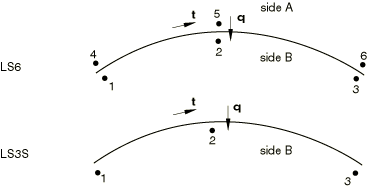Line spring element library | ||||||||
|
| |||||||
ProductsAbaqus/Standard
Element types
- LS6
6-node general second-order line spring
- LS3S
3-node second-order line spring for use on a symmetry plane
Active degrees of freedom
1, 2, 3, 4, 5, 6
Additional solution variables
None.
![]()
Nodal coordinates required
X, Y, Z required at each node and, optionally, , , (direction cosines of the normal to the shell) at each node.
A user-defined normal definition (see Normal definitions at nodes) can also be used to specify , , . If these are not specified, they are constructed as for all other shell elements—by averaging over the shell elements attached to each node.
![]()
Element property definition
The only element property used is the thickness; the number of integration points is ignored, since the elements work on the basis of section properties.
Input File Usage
Use the following option to define line spring element properties:
SHELL SECTION
Use the following option to define the depth of the crack as a function of position:
SURFACE FLAW
![]()
Element-based loading
Distributed loads
Distributed loads are specified as described in Distributed loads.
Three Gauss points are used for crack face pressure loading.
*dload- Load ID (*DLOAD): HP
- FL−2
Hydrostatic surface pressure on the crack faces, with magnitude varying linearly with the global Z-direction.
- Load ID (*DLOAD): P
- FL−2
Surface pressure on the crack faces.
![]()
Element output
Nodes 1, 2, and 3 on the element define side B and nodes 4, 5, and 6 define side A (see Figure 1). The sign of the crack is defined by the surface of the shell from which the crack originates, which you identify when you define the depth of the crack (see Line spring elements for modeling part-through cracks in shells). If the crack originates from the positive surface of the shell, sign(crack)=1.0; if the crack originates from the negative surface of the shell, sign(crack)=−1.0.
The vector is defined by the right-hand rule from the cross product of the tangent, , which is positive going from node 1 to node 3 of the element, and the normal, , defined when the coordinates are given (or by a user-defined normal definition). For element type LS3S the vector must point into the model (away from the symmetry plane). For element type LS6 the vector must point from side A to side B.
“Strains”
- E11
Mode I opening displacement,
- E22
Mode I opening rotation,
The following strains exist only for LS6:
- E33
Mode II through thickness shear,
- E12
Mode II rotation, (this strain plays no role)
- E13
Mode III antiplane shear,
- E23
Mode III opening rotation,
The conjugate forces and moments are available by requesting “stress” output.
The J-integral is provided at each integration point. If elastic-plastic material behavior is defined, the elastic and plastic parts of J are provided. The stress intensity factors, K, are also provided corresponding to the elastic parts of J.

![]()
Nodes associated with the element

![]()
Numbering of integration points for output
Three points (these points are at the nodes) are used for integration and element output. 